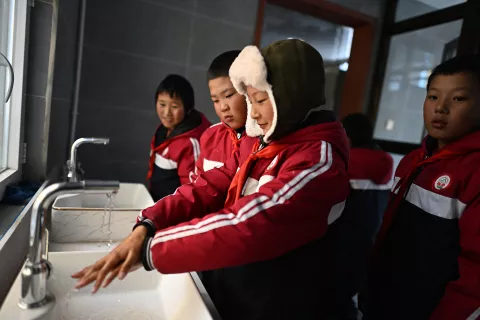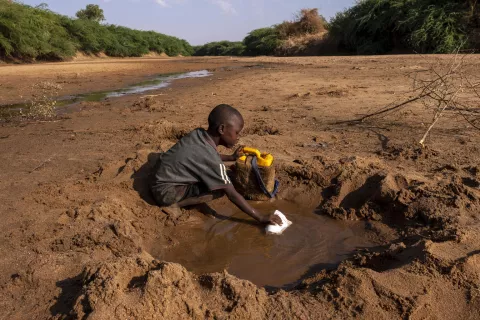Eliminating the Pain of Arsenic Poisoning
Eliminating the Pain of Arsenic Poisoning
- Available in:
- 中文
- English
A resident of Heihe, a village in western Inner Mongolia, 70-year-old Wang Er'ren often feels weak and short of breath. She remains bed-ridden for days. On a rare sunny day, she drags herself out and sits in a neighbor's doorway to chat with a friend.
Even during these relaxed moments, Wang Er'ren is careful not to reveal her right hand, wrapped completely in a small roll of white tissue. A victim of arsenic water poisoning for more than 40 years, she says the skin on her hands and feet have been affected since she was in her thirties.
Small, nail-like warts dot her palms and heels, hard and sharp enough to wear out the heels of her socks and keep her from doing much housework. And her right thumb developed an ulcer six years ago that became infected after she refused to have it amputated. “It aches almost unbearably and oozes blood with every movement,” says the strong-minded woman, who used to be the family breadwinner and head of the village women's federation.
Although she lives next door to her 40-year-old son and his family of four, Wang remains independent, cooking her own meals one-handed when her condition permits. She would prefer not to bother her son and daughter-in-law, and she hides her hand from others so they are not frightened.
Born in a neighboring county with high arsenic levels in the well water, Wang is not Heihe's only victim. More than 30 households used to draw water from the well that poisoned her. Villagers had no idea what was causing their suffering until 1990, when a medical team came from the provincial capital of Hohhot. The doctors had come to bring medicine to remote areas, but were stunned to see such a high incidence of keratotic hands and feet. They soon found the culprit: a village well contaminated with arsenic.
The well was abandoned and in 1994 a new, 80-meter tube well was drilled to provide better drinking water for Wang and her neighbors. But to a large extent, the damage had been done. Wang's husband had already died of lung disease. The son who lives next door to her has keratotic hands. Her other son, afflicted with a mental disorder, went missing six years ago and is suspected to be suffering nerve damage related to arsenic. <Just want to confirm all the afflictions in this paragraph were caused by arsenic, which is what the paragraph implies.>
“Chronic arsenic poisoning can harden the skin on hands and feet and change the color of your skin,” says Xia Yajuan, professor with the Center for Endemic Diseases Control & Research in Inner Mongolia. “It can also harm nerves in the brain and the tissues surrounding those nerves, impairing the senses of hearing, smell, and sight.”
Research also shows high arsenic intake may damage the respiratory system, resulting in cough, chest pain, tracheitis and tuberculosis. People who drink water with a high arsenic content are also more likely to develop malignant tumors.
The well water Wang Er'ren and her neighbors drank was contained 0.23 milligrams of arsenic per liter, more than four times the national standard. About 150 of the village's 1,800 inhabitants drank from the poisoned well. Of those, 60 percent or 90 people were poisoned.
Unfortunately, the tragedy does not end there. Zhang says a study of the village found that from the 1960s to the 1990s, more than 90 local farmers died of cancer of the lungs, liver, and bladder. “Six households perished as family members died one by one,” recalls the village chief, whose family was spared because they lived away from the arsenic belt.
In western Inner Mongolia, a 400-kilometer arsenic belt extends across land inhabited by 400,000 people. “The thorny part of the problem is that unlike fluoride poisoning, which can easily be detected by victims' blackened teeth, arsenosis is more elusive,” says Sun Guifan, vice chairman of the Fluoride and Arsenic Society of China. “Often the damage is done before it is noticed.”
What's worse, arsenic is irregularly distributed throughout the soil. It's common for one well to have a high arsenic content while its immediate neighbors remain pure.
Since 1999, the government of Inner Mongolia has allocated 5 million yuan a year (US $600,000) for water diversion projects in areas affected by arsenic. Villages like Heihe, which were among the earliest to be identified as contaminated, have been among the first to benefit.
China's central government earmarked 850 million yuan (US $102 million) in 2002 <more recent figures available?> for water projects in areas with high fluoride and arsenic content in the drinking water. An estimated 15 million people are exposed to high levels of arsenic in those areas, and 30,000 are already receiving treatment for some degree of poisoning.
UNICEF has joined these efforts by training health personnel on how to use test kits for rapid arsenic detection. UNICEF has delivered training in areas including Xinjiang, Inner Mongolia, Shanxi, Ningxia, Jilin, Qinghai, and Sichuan.
“Starting from 2001, our annual aid to China exceeds US $100,000,” says Yang Zhenbo, a program officer at UNICEF-China's Environment and Sanitation Section.
“In the last two years, we've provided 1,600 test kits at a price per-unit of US $34. Each kit can test water from 100 wells.”
Imported from Germany, the kits can detect arsenic levels in well water within 15 to 20 minutes. But given the magnitude of the problem, the cost remains high. Research on a localized test kit is under way, and Sun says he hopes the cost will be about half of the current imported one.
To date, says Sun, 21 of China's provinces, municipalities, and autonomous regions have reported high-arsenic water sources. This means a great amount of work remains to be done before the full extent of the contamination is known.
Now that they have tap water at home, arsenic exposure is already a remote story for children like Wang Er'ren's 9-year-old granddaughter. But for many others who still be drinking the water in ignorance, the suffering continues.




